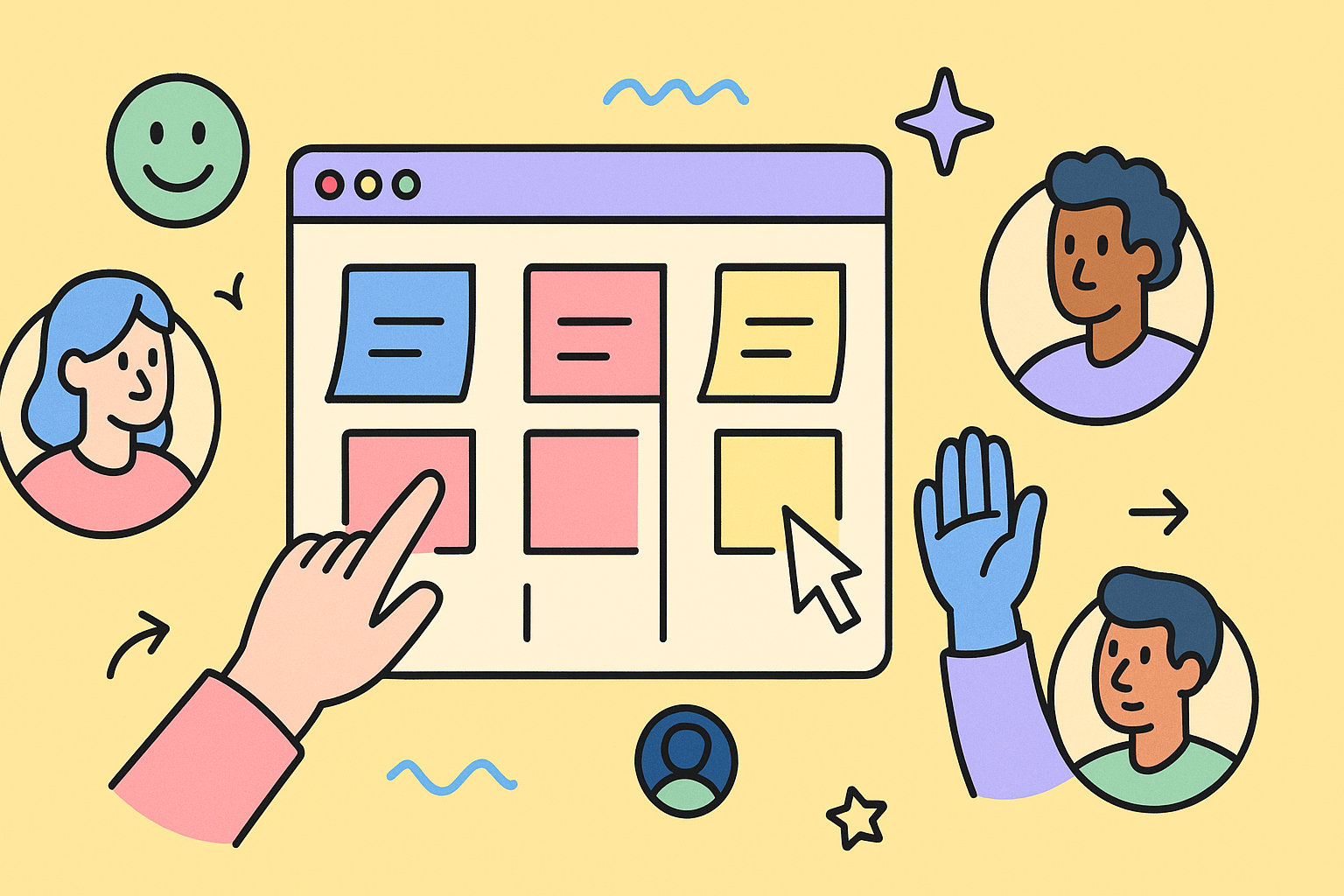The daily stand-up, a cornerstone of Agile and Scrum methodologies, is designed to be a quick, focused check-in. Yet, without structure, it can easily devolve into a lengthy, unproductive status report. The right stand up meeting template provides the necessary framework to keep your team aligned, identify blockers, and maintain momentum without wasting valuable time. This guide is built to help you find the perfect solution for your team’s specific workflow.
We have curated a list of the top platforms and tools offering robust templates for your daily huddles. Whether you are a remote team needing a collaborative digital whiteboard or a co-located group looking for a simple, structured format, this roundup has an option for you. Each entry provides a detailed overview of the template’s structure, key features, ideal use cases, and practical customization tips.
To make your decision easier, we have included screenshots for a visual preview and direct links to each resource. Our goal is to cut through the noise and deliver a straightforward comparison, enabling you to select and implement the best stand up meeting template quickly. Explore options from specialized tools like ClickUp and Atlassian Confluence to versatile whiteboards like Mural and Figma, and find the perfect fit to streamline your daily sync-ups.
1. resolution Reichert Network Solutions GmbH
For teams deeply embedded in the Jira ecosystem, resolution Reichert Network Solutions GmbH offers a standout solution that transforms the daily stand-up from a routine status report into a dynamic, action-oriented session. Their flagship product, NASA – Not Another Standup App, is a powerful agile meeting facilitation tool designed to integrate directly into your existing Jira workflow, making it a premier choice for software development teams, Scrum Masters, and project managers.
NASA’s core strength lies in its hybrid approach to meeting facilitation. It masterfully combines asynchronous updates with live, structured discussions. This allows team members to log their progress and blockers before the meeting starts, freeing up valuable synchronous time to focus on problem-solving and strategic alignment rather than simple reporting.
Key Features and Capabilities
NASA is more than just a digital stand up meeting template; it’s a comprehensive facilitation platform. It ensures every meeting is efficient, inclusive, and directly tied to project outcomes.
- Structured Agendas: Utilize preset agendas with timed segments to keep the meeting on track and goal-oriented. The turn-based sharing mechanism guarantees that every participant, from the most outspoken to the most reserved, has an equal opportunity to contribute.
- Deep Jira Integration: This is NASA’s defining feature. Meeting outcomes, flagged issues, and action items are not just recorded; they are linked directly to corresponding Jira tickets. This seamless connection ensures immediate accountability and maintains momentum within your project sprints.
- Enhanced Engagement: Move beyond monotonous updates with interactive tools. Emoji reactions and mood indicators provide a quick, visual gauge of team sentiment and morale, fostering a more transparent and connected team culture.
- Centralized Meeting Journals: Every session is meticulously documented. The platform captures notes, attendance, sentiment metrics, and follow-up tasks in a centralized journal, creating a searchable history that aids in continuous improvement and knowledge sharing.
- High-Level Customization: NASA adapts to your team’s unique needs. You can customize agendas, define participant roles, set meeting cadences, and manage multiple team streams, making it suitable for various agile methodologies and complex enterprise environments.
Practical Implementation
To get the most out of NASA, encourage your team to fully adopt the asynchronous update feature. Before each stand-up, team members should briefly outline their progress and any impediments within the app. This simple habit shifts the live meeting’s focus from “What did you do?” to “How can we solve this blocker together?”.
For those new to this structure, resolution provides excellent resources. You can learn more about how to run effective daily stand-up meetings to maximize the tool’s impact from day one.
Pricing and Access
While NASA is trusted by over 8,000 customers, specific pricing details are not publicly listed. You must contact the resolution team directly or book a demo for a quote tailored to your organization’s size and needs. This approach, while requiring an extra step, ensures you receive a solution configured for your specific environment.
Website: resolution Reichert Network Solutions GmbH
| Pros | Cons |
|---|---|
| Integrates seamlessly with Jira, linking meeting outcomes directly to project tasks for clear accountability. | Pricing is not publicly available and requires direct contact, which can slow down the initial evaluation process. |
| Combines asynchronous updates with live discussions to maximize the efficiency of meeting time. | The extensive feature set is optimized for Jira and agile frameworks, potentially requiring training for new users. |
| Structured agendas, timers, and turn-based sharing promote balanced participation and focused conversations. | |
| Centralized journals provide a comprehensive record of notes, sentiment, and action items for continuous improvement. | |
| Highly customizable to support diverse agile workflows, multiple teams, and specific organizational requirements. |
2. ClickUp
ClickUp positions itself as an all-in-one productivity platform, and its approach to stand-up meetings reflects this comprehensive philosophy. Instead of just providing a static document, ClickUp offers a dynamic stand up meeting template that integrates directly into your team’s workflow. This allows teams to not only structure their daily check-ins but also to connect those discussions directly to actionable tasks, goals, and project timelines within the same ecosystem.
The platform excels at transforming the stand-up from a simple reporting session into a strategic alignment tool. By embedding the meeting agenda within the project management environment, it ensures that every update, blocker, and plan is captured and tracked. The seamless integration means that notes taken during the meeting can immediately be converted into tasks, assigned to team members, and given due dates, closing the loop between discussion and execution.
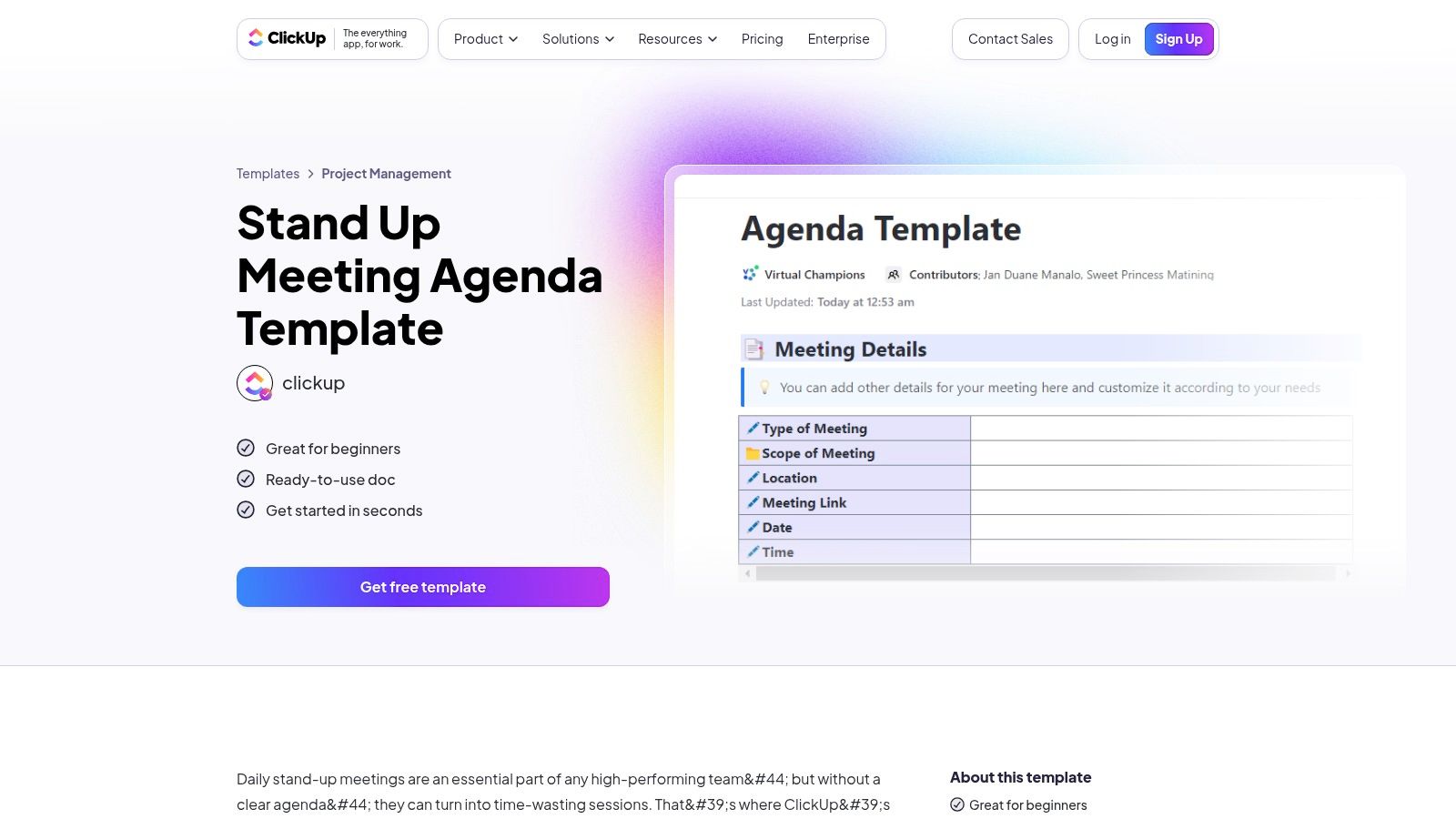
Key Features and Implementation
ClickUp’s template is highly adaptable to different team needs. Its strength lies in its customizable structure and deep integration with project management features.
- Customizable Structure: The pre-designed template provides a solid foundation, but you can add custom fields for tracking metrics like “Confidence Score” or “Priority Level.” This helps quantify team sentiment and focus on the most critical items.
- Multiple Views: Accommodate different working styles by switching between views. A List view is great for a linear agenda, a Board view helps visualize progress like a Kanban board, and a Calendar view shows how stand-up topics align with project deadlines.
- Actionable Items: Turn any point discussed in the stand-up into a task with a single click. Assign it, set a priority, and add it to a sprint. This direct link from conversation to action is a major advantage. To dive deeper into structuring your meeting notes for maximum impact, you can explore detailed strategies for creating a powerful template for meeting notes.
Pricing and Access
ClickUp operates on a freemium model. The Free Forever plan is quite generous and includes the stand-up meeting template, making it accessible for small teams or those just starting out. However, for more advanced features like custom field permissions, advanced automations, and extensive integrations, you’ll need to upgrade to a paid plan, which starts with the Unlimited tier. The platform’s user-friendly interface makes it easy for beginners to get started, though mastering its full suite of features can present a learning curve.
3. Figma (FigJam)
Figma’s online whiteboard tool, FigJam, brings a highly visual and interactive approach to daily check-ins with its stand up meeting template. Designed for collaborative teams, especially those in creative or design-centric fields, FigJam transforms the stand-up from a verbal-only update into a dynamic, hands-on session. This platform allows teams to visually map out their progress, blockers, and plans on a shared digital canvas, making it an ideal solution for remote and hybrid teams seeking greater engagement.
The core strength of FigJam lies in its ability to make the stand-up meeting a tangible, shared experience. Instead of just listening to updates, team members use digital sticky notes, diagrams, and comments to interact with the agenda in real-time. This visual format not only clarifies individual contributions but also fosters a more creative and collaborative environment, turning the daily huddle into an opportunity for collective brainstorming and problem-solving.
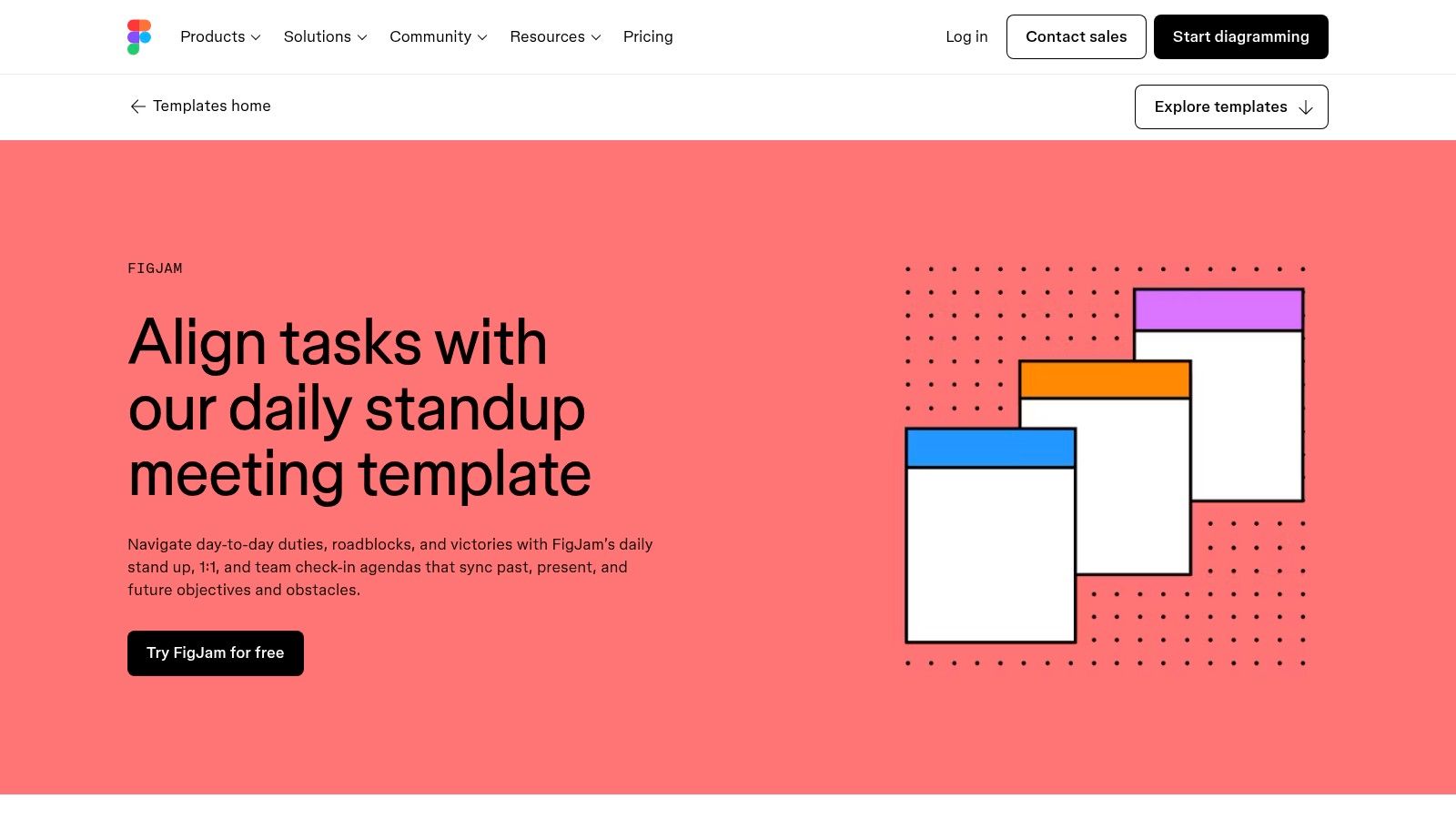
Key Features and Implementation
FigJam’s template is all about fostering interaction and clarity. Its features are geared toward making the meeting fun, engaging, and productive.
- Interactive Whiteboard: The template is built on an infinite canvas where team members can simultaneously add sticky notes for their updates on “What I did,” “What I’m doing,” and “Blockers.” This real-time participation keeps everyone engaged.
- Customizable Sections: While the template provides a classic stand-up structure, you can easily add or modify sections. Many teams add areas for “Kudos” to celebrate wins or a “Parking Lot” for topics that require longer discussion outside the meeting.
- Integration with Figma: For design and product teams, the direct link to Figma is a significant advantage. You can easily embed design mockups or prototypes directly into the FigJam board, allowing for immediate visual context during discussions about specific tasks.
- Engaging Tools: Use stamps, emojis, and a timer to keep the meeting on track and maintain a positive, high-energy atmosphere. The timer is particularly useful for ensuring each person’s update remains concise.
Pricing and Access
Figma offers FigJam through a freemium model. The Free plan provides access to three collaborative FigJam files, which is often sufficient for a small team to use the stand up meeting template. This makes it highly accessible for teams wanting to try a more visual approach without any initial investment. For unlimited files and more advanced features like team libraries and private plugins, you would need to upgrade to the Professional plan or higher. The interface is intuitive, especially for those familiar with design tools, but its highly visual nature may be a shift for teams accustomed to text-based templates.
4. Mural
Mural positions itself as a digital whiteboard built for visual collaboration, and its stand up meeting template fully embodies this philosophy. Instead of a linear document or a task list, Mural offers a dynamic and interactive canvas where teams can visually organize their daily check-ins. This approach is particularly effective for remote and hybrid teams, transforming the stand-up from a series of monologues into an engaging, collaborative session.
The platform excels at making abstract concepts like progress and blockers tangible. By using digital sticky notes, icons, and voting tools, Mural’s Ultimate Team Stand-Up Template helps teams align on priorities, visualize dependencies, and foster a shared sense of ownership. It turns the meeting into a living document that captures not just what was said, but the context and sentiment behind each update, making it a powerful tool for improving team communication.
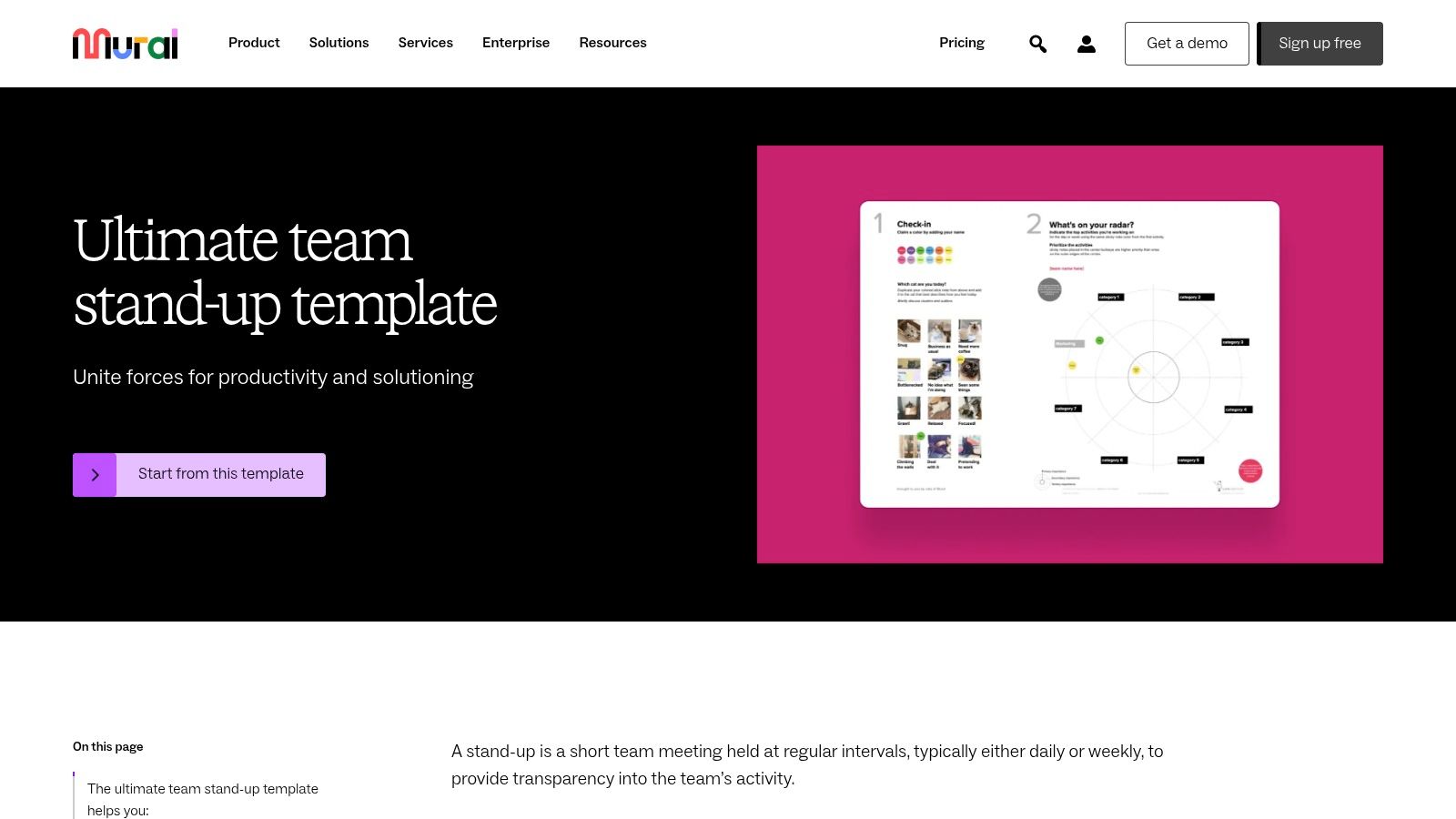
Key Features and Implementation
Mural’s template is designed for high-touch interaction and visual clarity. Its strength lies in its flexible, canvas-based structure that encourages active participation.
- Visual Framework: The template is pre-structured with dedicated areas for check-ins, priorities, and blockers. Team members add their updates on digital sticky notes, which can be color-coded, tagged, and moved around the board, making it easy to see patterns and connections.
- Interactive Elements: Mural includes features like timers to keep the meeting on track, voting sessions to quickly prioritize blockers, and icebreaker prompts to boost team morale. These tools make the stand-up more dynamic and less of a passive reporting exercise.
- Centralized Task and Blocker Board: A dedicated section allows the team to collectively manage tasks and address impediments. Blockers can be visually highlighted and assigned for resolution, ensuring nothing falls through the cracks. This visual approach is a core part of effective team collaboration strategies.
Pricing and Access
Mural offers a Free plan that allows up to three murals, making its stand up meeting template accessible for small teams to try. This plan is ideal for getting a feel for the platform’s visual collaboration tools without any financial commitment. For unlimited murals, more advanced facilitation features, and enterprise-level security, teams will need to upgrade to a paid plan, starting with the Team+ tier. While the visual interface is intuitive, new users may need some time to adapt to a whiteboard-style workflow compared to traditional list-based tools.
5. Moqups
Moqups is widely known as a visual collaboration tool for wireframing and prototyping, but it also offers a surprisingly effective stand up meeting template. Its strength lies in its visual and spatial approach, turning the daily check-in into a shared digital whiteboard experience. This makes it ideal for teams that thrive on visual organization and want to keep their stand-up artifacts alongside their design mockups and flowcharts.
The platform treats the stand-up not just as a list of updates, but as a collaborative space. Teams can use pre-structured sections for accomplishments, current tasks, and blockers, all within a flexible, drag-and-drop environment. This allows for a more dynamic and interactive session where team members can visually connect their updates to specific project elements or user stories, fostering a deeper, shared understanding of progress and priorities.
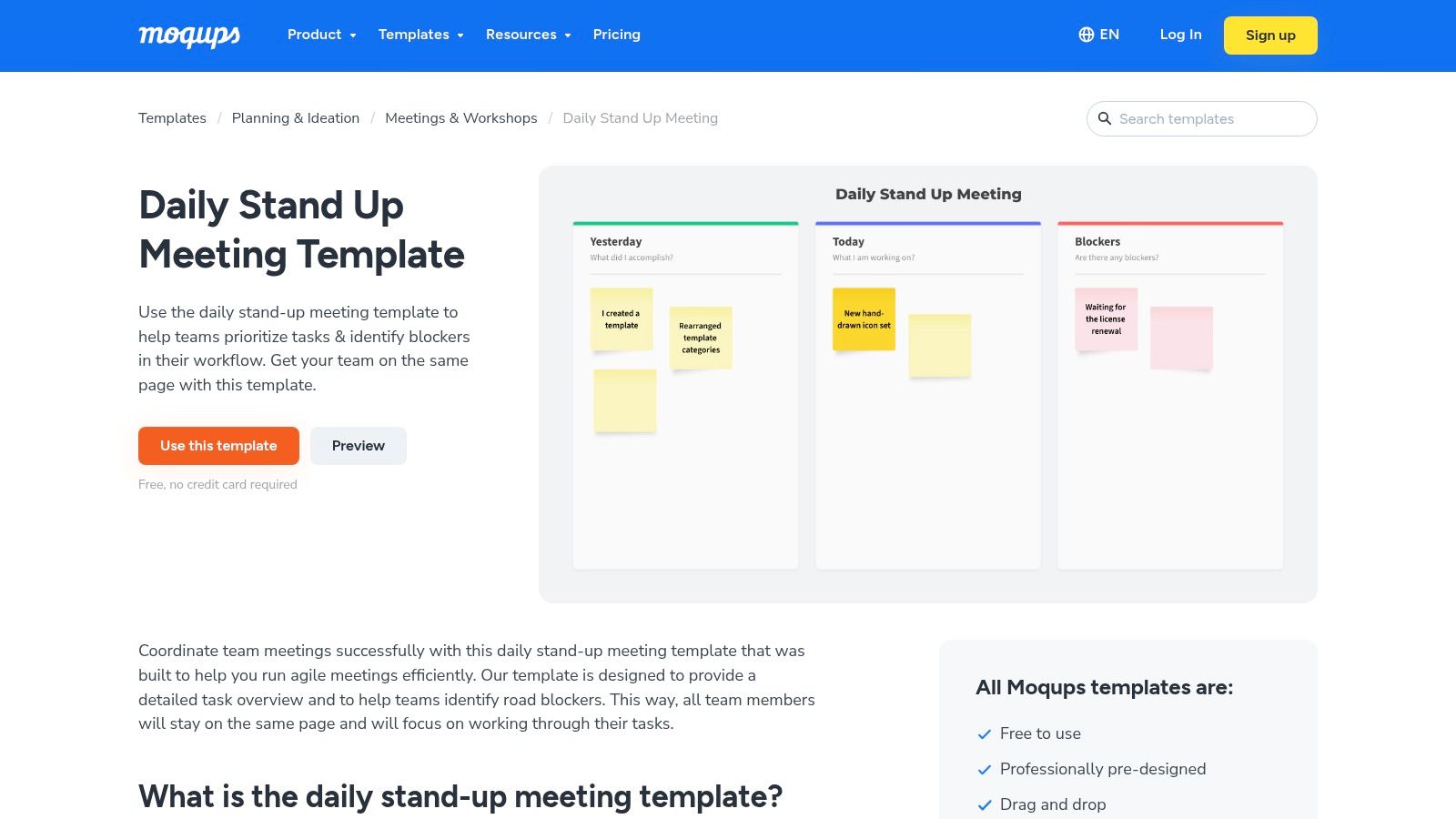
Key Features and Implementation
Moqups’ template is designed for simplicity and visual clarity. It leverages the platform’s core whiteboard functionality to create a clear, organized, and collaborative meeting space.
- Pre-Structured Visual Layout: The template provides dedicated columns for “What I did yesterday,” “What I’ll do today,” and “Blockers/Impediments.” This classic structure is presented on an infinite canvas, allowing teams to add notes, sticky notes, or icons freely.
- Drag-and-Drop Interface: The user-friendly interface makes it easy for any team member to add their updates without a learning curve. You can drag cards between columns or link them to other diagrams on the board, making it simple to visualize dependencies.
- Customizable for Team Needs: While the template provides a solid starting point, you can easily customize it. Add new sections for “Kudos” or “Parking Lot” items, change colors to represent different team members, or adjust the layout to fit your team’s unique workflow. For more ideas on structuring your meeting, you can refine your stand up meeting agenda for maximum effectiveness.
Pricing and Access
Moqups offers a tiered pricing model. There is a free plan that allows for one project with a limit on objects, which can be sufficient for a small team to try out the stand-up template. For full access to unlimited projects, real-time collaboration, and advanced features, teams will need to subscribe to one of the paid plans, which start with the Pro tier. The platform is entirely web-based, making it accessible from any browser without requiring any software installation.
6. SlideEgg
For teams that prefer a more traditional, presentation-style format for their daily check-ins, SlideEgg offers a visually engaging stand up meeting template for PowerPoint, Google Slides, and Canva. Instead of integrating into a complex project management tool, SlideEgg provides a clean, professional slide deck that structures the meeting’s flow. This approach is ideal for teams that present their updates in a more formal or visual manner, whether in a conference room or during a screen-share on a video call.
This template transforms the stand-up into a polished presentation, ensuring that each participant’s updates are displayed clearly and consistently. By using a slide-based format, teams can easily archive a visual record of each day’s meeting, creating a simple, browsable history of project progress, goals, and roadblocks. It’s a straightforward solution for those who want a dedicated, easy-to-use template without the overhead of a full-fledged software platform.
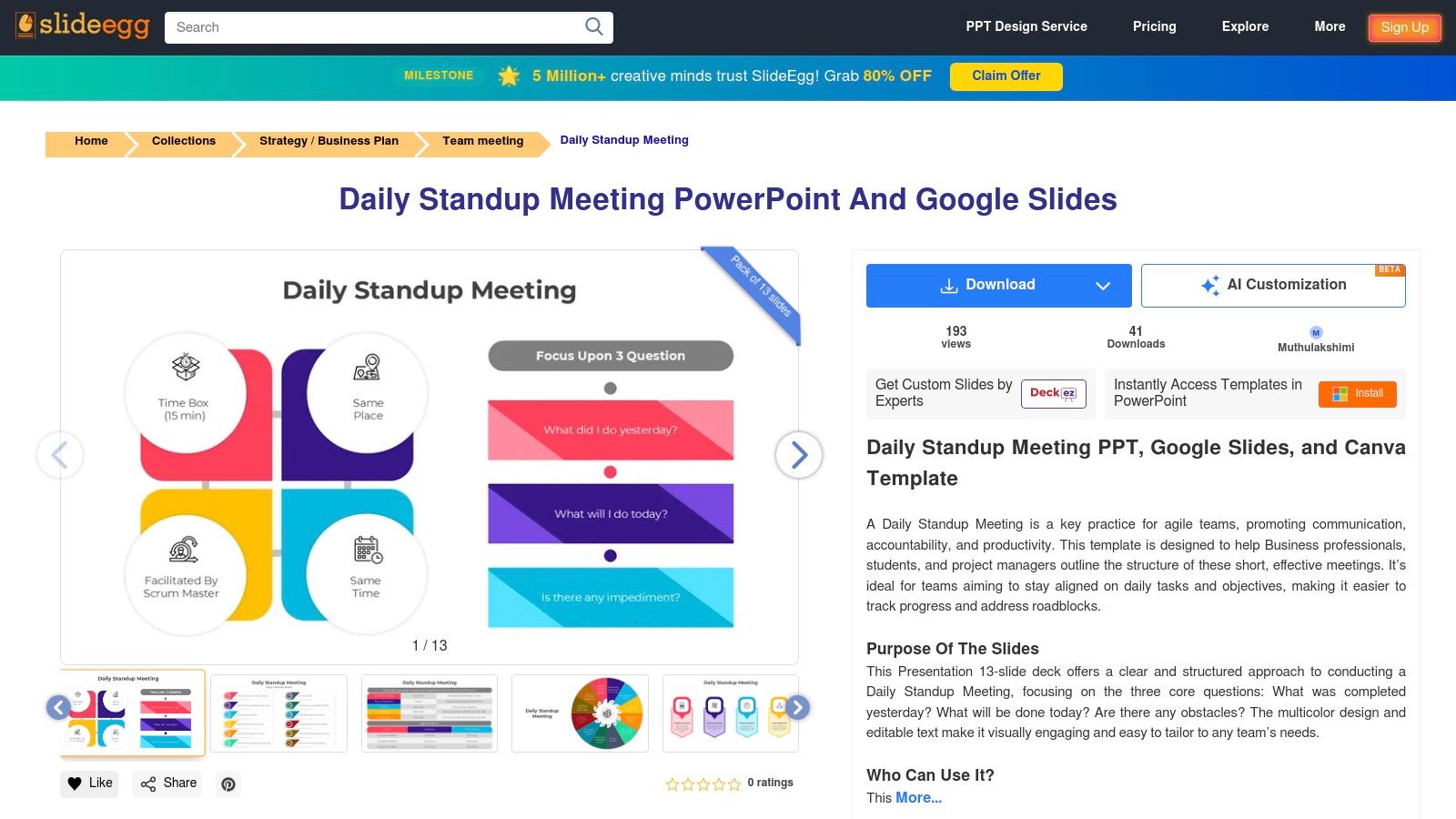
Key Features and Implementation
SlideEgg’s strength is its simplicity and visual appeal, offering a plug-and-play solution for structuring daily meetings. The template is designed for quick adoption and easy customization.
- Pre-Structured Slide Deck: The template comes as a 13-slide deck with dedicated sections for the agenda, individual updates (Yesterday, Today, Blockers), and key takeaways. This provides a clear, linear path for the meeting to follow.
- Multi-Platform Compatibility: One of its main advantages is its compatibility with major presentation software. You can download and use the template in PowerPoint, open it directly in Google Slides for cloud-based collaboration, or even edit it in Canva for more creative design options.
- Fully Editable Content: Every element on the slides is customizable. You can change the text, insert company logos, and adjust the multicolor design to match your brand or team’s aesthetic, making the stand up meeting template feel uniquely yours.
Pricing and Access
SlideEgg provides this specific template for free download directly from their website, making it highly accessible for any team, regardless of budget. You can visit the Daily Standup Meeting page and download the template with just a few clicks. While this template is free, SlideEgg operates on a freemium model, offering a vast library of premium slides and more advanced presentation templates through subscription plans. The user experience is straightforward; no account is needed for many free downloads, though some may require an email signup. This makes it an excellent choice for teams needing a quick, no-cost, and visually organized stand-up solution.
7. Atlassian Confluence
Atlassian Confluence is a knowledge management and collaboration tool that serves as a central source of truth for teams. Its approach to the stand up meeting template leverages this core strength, providing a structured, shareable document that lives alongside project plans, documentation, and team knowledge. This integration ensures that daily updates are not lost in ephemeral chats but are captured, archived, and linked directly to the broader project context.
The platform is particularly powerful for teams already embedded in the Atlassian ecosystem. Confluence transforms the stand-up from a simple verbal update into a documented, asynchronous-friendly process. It allows team members to contribute their updates on their own time, making it ideal for distributed or global teams. The template creates a historical record of progress, blockers, and decisions, enhancing accountability and transparency within the project lifecycle.
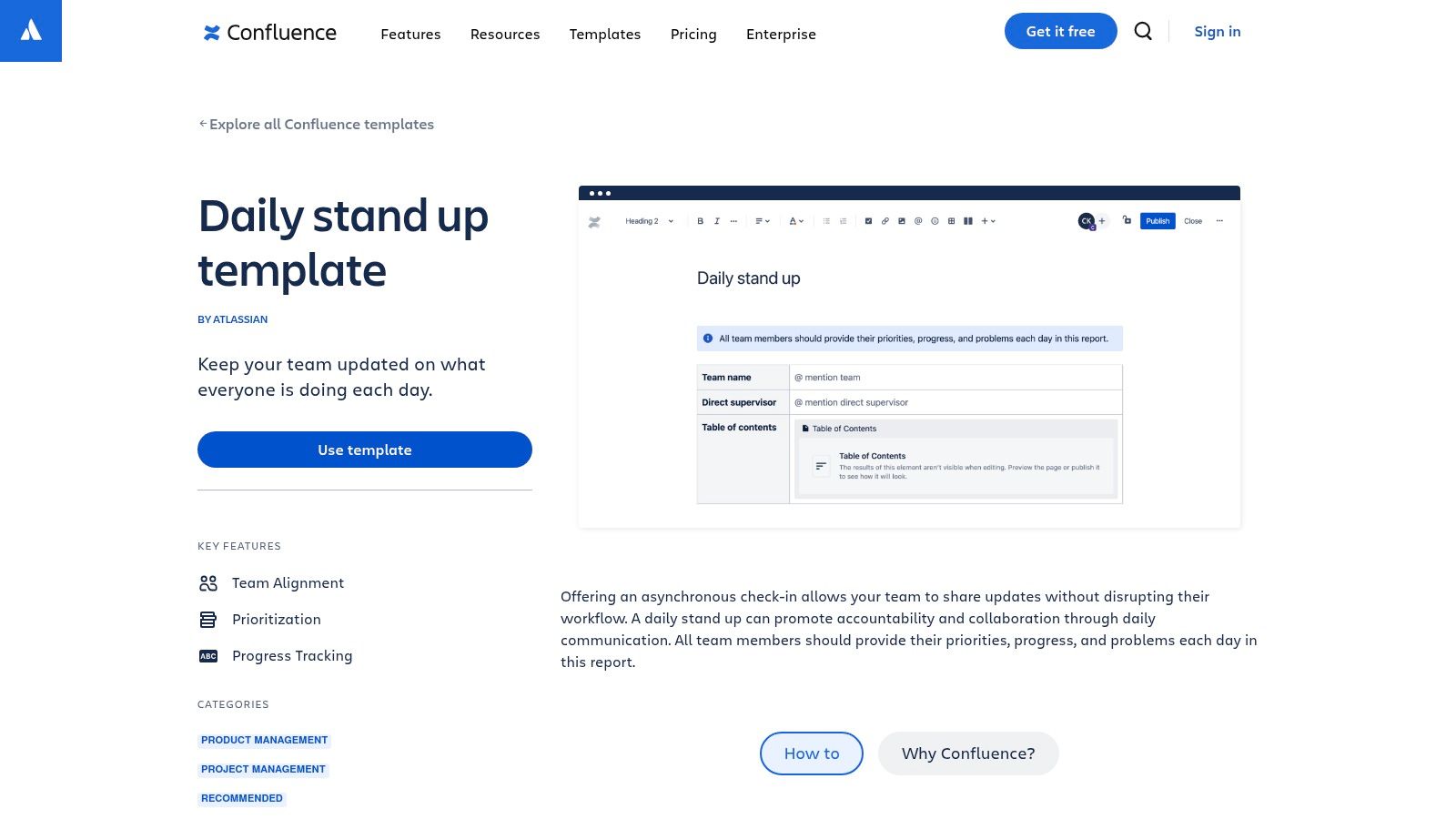
Key Features and Implementation
Confluence’s template shines through its simplicity and deep integration with other Atlassian products, especially Jira. It’s designed to be a straightforward yet effective tool for Agile teams.
- Structured Format: The template comes with pre-defined sections for each team member to list their priorities, progress, and any problems or blockers. This classic “Yesterday, Today, Blockers” format keeps updates concise and focused.
- Deep Jira Integration: This is Confluence’s standout feature. You can directly link to or embed Jira issues within the stand-up page. This allows the team to see the specific tasks being discussed without leaving Confluence, streamlining the workflow between planning and execution.
- Collaborative Editing: Like any Confluence page, the template supports real-time collaborative editing. Multiple team members can add their updates simultaneously, and others can use inline comments to ask questions or offer help directly on a specific point. For a more detailed guide on structuring these sessions, you can explore this effective Scrum meeting agenda template.
Pricing and Access
Confluence offers a Free plan that supports up to 10 users and includes the daily stand-up template, making it highly accessible for small teams and startups. Larger teams or those needing advanced features like granular permissions and unlimited storage will need to subscribe to a paid plan, starting with the Standard tier. While powerful, users new to the Atlassian ecosystem may experience a learning curve as they get accustomed to the platform’s interface and vast feature set.
Stand-Up Meeting Template Tools Comparison
| Item | Implementation Complexity 🔄 | Resource Requirements ⚡ | Expected Outcomes 📊 | Ideal Use Cases 💡 | Key Advantages ⭐ |
|---|---|---|---|---|---|
| resolution Reichert Network Solutions GmbH (NASA) | Medium – requires Jira familiarity and onboarding | Moderate – Jira integration, customizable settings | High – structured, efficient standups with actionable follow-ups | Agile software/IT teams using Jira and Scrum workflows | Seamless Jira linkage, balanced participation, detailed meeting journals |
| ClickUp | Low – easy to start with templates | Low to Moderate – subscription may be needed | Medium – improved alignment and accountability | Teams seeking simple standup integration within PM tool | User-friendly, customizable, integrates with PM tools |
| Figma (FigJam) | Medium – familiarity with Figma needed | Moderate – collaborative tool with design focus | Medium – enhanced engagement and creativity | Design-centric or remote teams emphasizing visual collaboration | Interactive, visual, supports creativity and remote work |
| Mural | Medium – adaptation time may be needed | Moderate – some features behind paywall | Medium – transparency and dynamic meetings | Remote/dynamic teams needing interactive frameworks | Visual organization, remote collaboration, interactive |
| Moqups | Low – straightforward and user-friendly | Low to Moderate – may need subscription | Medium – clear task prioritization and communication | Teams wanting simple, customizable standup meetings | Simple, user-friendly, integrates with PM tools |
| SlideEgg | Low – presentation-style setup | Low – PowerPoint/Google Slides compatible | Low to Medium – structured but less interactive | Teams preferring visual deck-based meeting agendas | Clear structure, easy customization, multi-platform |
| Atlassian Confluence | Medium – requires Confluence account | Moderate – Atlassian ecosystem access | Medium to High – aligned updates, strong integration | Teams using Atlassian tools for project management | Seamless Atlassian integration, asynchronous updates |
Final Thoughts
We’ve explored a diverse range of powerful tools, each offering a unique stand up meeting template to streamline your daily syncs and enhance team collaboration. From the highly structured, Jira-integrated environment of Atlassian Confluence to the free-form visual creativity of FigJam and Mural, the right solution exists to fit your team’s specific workflow and culture. The key isn’t just finding a template, but finding the right template and adapting it to serve your team’s goals.
The journey from chaotic, unfocused stand-ups to efficient, value-driven huddles begins with intentionality. A well-chosen template provides the necessary structure, transforming your daily check-in from a routine status report into a dynamic problem-solving and alignment session.
Your Path to a Better Stand-Up
To make a tangible difference, move from reading to doing. Here are your actionable next steps to implement a superior stand up meeting process:
- Assess Your Current State: Before you choose a new tool, analyze what isn’t working with your current stand-up. Are meetings too long? Is engagement low? Are blockers not being resolved? Pinpointing the exact problem will guide your choice.
- Match the Tool to Your Team’s DNA: Consider your team’s primary platform and workflow.
- Heavily invested in the Atlassian ecosystem? Atlassian Confluence and Jira-integrated solutions are your most logical starting point.
- A design-centric or visual-thinking team? FigJam or Mural will feel like a natural extension of your creative process.
- Need an all-in-one project management hub? ClickUp provides comprehensive templates within a broader productivity suite.
- Focused on formal presentations for stakeholders? SlideEgg offers a polished, professional format.
- Run a Pilot Program: Don’t enforce a new tool on the entire team overnight. Select a small, willing group or a single project to pilot a new stand up meeting template. Gather feedback after a week or two. This iterative approach ensures buy-in and helps you refine the process before a full rollout.
- Customize and Iterate: No template is one-size-fits-all. Use the templates from these tools as a starting point. Feel empowered to add, remove, or modify sections. Maybe your team needs a “Kudos” section to boost morale or a dedicated “Parking Lot” for off-topic discussions. Continuously ask for feedback and be prepared to adapt.
The Real Goal: Fostering Connection and Progress
Ultimately, the purpose of any stand up meeting template is to remove friction and foster a culture of transparency, accountability, and proactive problem-solving. The best template is the one your team actually uses and finds value in, a tool that becomes an invisible and indispensable part of your daily rhythm. By choosing thoughtfully and implementing strategically, you can transform your daily stand-up into the most valuable 15 minutes of your team’s day.
Ready to supercharge your stand-ups directly within your Atlassian environment? For teams seeking deep integration and powerful customization, explore the innovative solutions from resolution Reichert Network solutions GmbH. Their tools are designed to enhance your existing Jira and Confluence workflows, making it easier than ever to implement and manage an effective stand up meeting template that truly works for your team.
